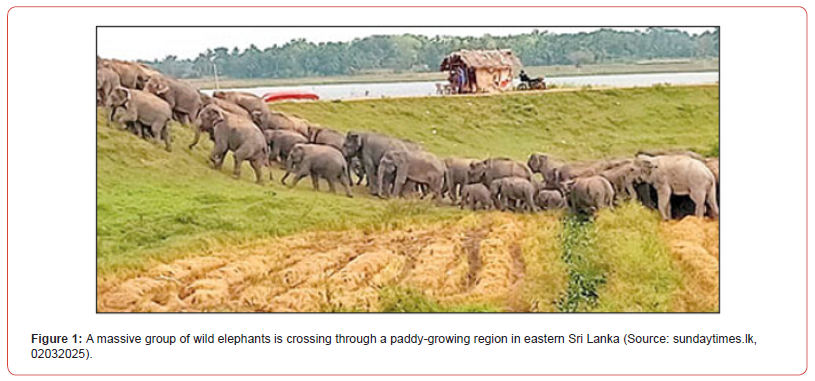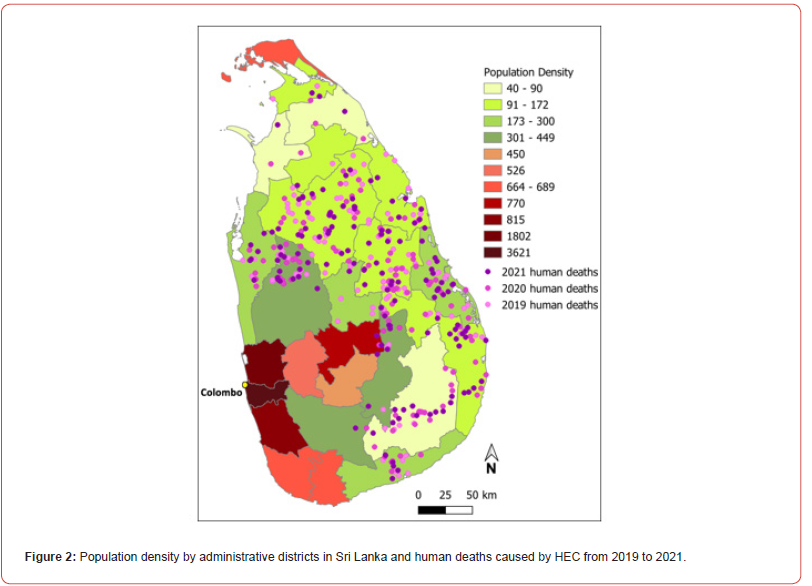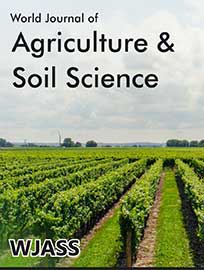 Opinion
Opinion
The Impact of Human Elephant Conflict on Village Life in Sri Lanka
Kithsiri Perera1*, and Thakshila D Gunawansa2
1School of Surveying and Built Environment, Faculty of Health, Engineering and Sciences, University of Southern Queensland, Toowoomba, Australia
2Department of Engineering Technology, Faculty of Technological Studies, Uva Wellassa University, Badulla, Sri Lanka
Corresponding AuthorKithsiri Perera, School of Surveying and Built Environment, Faculty of Health, Engineering and Sciences, University of Southern Queensland, Toowoomba, Australia
Received Date:October 14, 2025; Published Date:October 24, 2025
Abstract
Human-Elephant Conflict (HEC) is a critical socio-economic and environmental issue in elephant range countries, including Sri Lanka. Humans and elephants are facing a grave threat due to the conflict between them in various parts of the island nation of Sri Lanka. In Sri Lanka, about 2% of the global elephant count (or about 5,787 elephants) lives in their natural habitat. When the estimated elephant population is divided by the land area of the respective country, Sri Lanka had a density of 0.088 per km2 in 2008, causing a severe environmental issue due to the limited land resources. With the significant increase in the country’s human population, elephants are now restricted to the forest regions in the dry zone lowlands. Figure 1 shows a large group of elephants crossing a farming area in rural Sri Lanka, highlighting the conflict’s severity for agricultural villages.
Keywords:Environmental issue; land; agriculture; wildlife conservation; socioeconomic
Introduction
Human-Elephant Conflict (HEC) is a critical socio-economic and environmental issue in elephant range countries, including Sri Lanka [1]. Humans and elephants are facing a grave threat due to the conflict between them in various parts of the island nation of Sri Lanka [2-4]. In Sri Lanka, about 2% of the global elephant count (or about 5,787 elephants) lives in their natural habitat [5]. When the estimated elephant population is divided by the land area of the respective country, Sri Lanka had a density of 0.088 per km2 in 2008 [6], causing a severe environmental issue due to the limited land resources. With the significant increase in the country’s human population, elephants are now restricted to the forest regions in the dry zone lowlands. Figure 1 shows a large group of elephants crossing a farming area in rural Sri Lanka, highlighting the conflict’s severity for agricultural villages (Figure 1).

The HEC of Sri Lanka and its Impact on Agriculture

Elephants have a massive daily dietary requirement, around 150 kg of green matter [7]. This requirement fuels the conflict in Sri Lanka, leading to significant effects on agriculture, especially in rural regions of the island. Apart from regular crop destruction, HEC threatens the livelihoods and food security of villagers as well as the elephants. While farmers lose their income and spend heavily on crop protection, with little government compensation, traditional beliefs and government regulations are banning them from confronting elephants directly without the involvement of wildlife authorities. This conflict drives economic losses for farmers and the nation, contributes to the socioeconomic insecurity of communities, and escalates retaliatory killings of elephants, which are an endangered species. The severity of the HEC in rural Sri Lanka is presented in (Figure 2), which shows the number of human deaths from 2019 to 2021 due to elephant attacks and the population density of each district of Sri Lanka. According to data gathered from the Department of Wildlife Conservation, Sri Lanka, the map shows that nearly all casualties occur outside the island’s highly populated districts. The habitat and conflict zones also coincide with many of the rice paddies and irrigated tanks in Sri Lanka, as well as natural forests and protected areas [8].
The Conflict Mitigation and Concluding Remarks
To address the damage caused to rural farmlands, elephants must move to new habitats. Simultaneously, elephant habitats overlapping with human activities are affected by multiple development goals, such as agriculture and transportation (Figure 2). The increase in various crop cultivation and construction projects, including highways, is critically affected by the HEC mitigation efforts. In other words, human activities continue to encroach on the living spaces of elephants in different ways. Sri Lanka had approximately 5,787 elephants in 2011, and the range has been shrinking in the forest regions in the dry zone (east and northeast of Sri Lanka). Furthermore elephants are geographically trapped on the island of Sri Lanka and face a limited habitat. The government may be involved in solutions such as establishing electrical fences or buffer zones to separate villages from elephant habitats. However, the effective success of mitigation methods is still not well established.
Acknowledgement
None.
Conflict of Interest
No conflict of interest.
References
- Shaffer LJ, Khadka KK, Van Den Hoek J, Naithani KJ (2019) Human-Elephant Conflict: A Review of Current Management Strategies and Future Directions. Frontiers in Ecology and Evolution 6: 235.
- Thant ZM, May R, Røskaft E (2021) Pattern and distribution of human-elephant conflicts in three conflict-prone landscapes in Myanmar. Global Ecology and Conservation 25: e01411.
- Perera K, Tsuchiya K (2009) Experiment for mapping land cover and it's change in southeastern Sri Lanka utilizing 250 m resolution MODIS imageries. Advances in Space Research 43(9): 1349-1355.
- Nikhil Advani (2015) Asian Elephant - WWF wildlife and climate change series. World Wildlife Fund.
- Fernando P, Pastorini J (2011) Range-wide status of Asian elephants. Gajah (35): 15-20.
- Perera K, Tateishi R (2012) Supporting elephant conservation in Sri Lanka through MODIS imagery. Proceedings of SPIE - The International Society for Optical Engineering PP. 8524.
- Samansiri K, Weerakoon DK (2006) Feeding behaviour of Asian elephants in the northwestern region of Sri Lanka. Gajah, 27: 27-34.
- Rathnayake CWM, Jones S, Soto-Berelov M, Wallace L (2022) Human–elephant conflict and land cover change in Sri Lanka. Applied Geography 143: 102685.
-
Kithsiri Perera*, and Thakshila D Gunawansa. The Impact of Human Elephant Conflict on Village Life in Sri Lanka. World J Agri & Soil Sci. 9(5): 2025. WJASS.MS.ID.000721.
-
Environmental issue; land; agriculture; wildlife conservation; socioeconomic; iris publishers; iris publisher’s group
-

This work is licensed under a Creative Commons Attribution-NonCommercial 4.0 International License.






